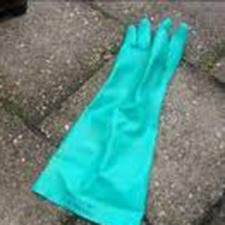Page content
Refer to Safety Data Sheet for the Appropriate Personal Protective Equipment
Section 8 of the Safety Data Sheet (SDS) of a product provides information on personal protective equipment. This information can be found in the local hazardous substances registration system and the associated NFU Hazardous Substances Database. You are obliged to wear personal protective equipment if this is prescribed due to the risks. Your umc must purchase the right PPE and provide information about their use.
Regular glasses or safety glasses

If you wear regular glasses, you don't always have to wear safety glasses. Normal glasses of a sufficiently large surface, possibly supplemented with a protective cap for the sides, are sufficient for simple manual work. However, with equipment with pressurized liquid, hazardous substances can be sprayed into your face with more force and volume and special safety glasses are necessary. There are special safety glasses for sale to wear over regular glasses. Sometimes prescription safety glasses can be fitted.
Using the Right Gloves in the Right Way

There are many types of gloves. The type of glove you need to use depends on the work and the type of hazardous substance.
In a healthcare department, you can use disposable nitrile gloves to protect against exposure to hazardous substances. See the photo. When choosing the type of disposable glove, the property of the hazardous substance is decisive.
Short-term work
For short-term work, disposable gloves provide protection against exposure to chemicals. If they are made of nitrile, they are good to reasonably resistant to most chemicals and do not cause a latex allergy. Splash protection always applies to a disposable glove: take off the glove immediately after (suspected) contact and replace it.
Long-term work
For work that involves long-term exposure to hazardous substances on the hands, you should use a special safety glove that is resistant to the chemical. For example, there are gloves intended for working with strong and less strong acids, alkalis, dry ice, liquid nitrogen, blood products and even oils and fats. These special heavy gloves can be reused after cleaning.
You can see how to put on and take off gloves correctly in the video Responsible glove use.
Under Skin load you will find more information about glove use.
If you work with cytostatics, you can find more information about the use of gloves here.
Detergents: wear glasses, apron and gloves at least

The washing machines of the umcs clean with concentrated detergents. These concentrated agents consist of acid and lye. If you need to pour detergents or connect barrels, follow the department's procedure. Then wear at least glasses, apron and suitable gloves.
Filling always requires protection

When transferring substances, use at least glasses or face shields and suitable gloves. Depending on the type of hazardous substance, a suitable (plastic) apron and suitable footwear are important. In large quantities, even respiratory protection is required and grounding must be present to prevent static discharge. Moreover, you may only fill large quantities in a room that is suitable and equipped for filling.
